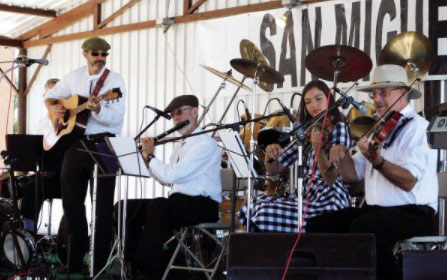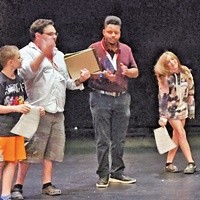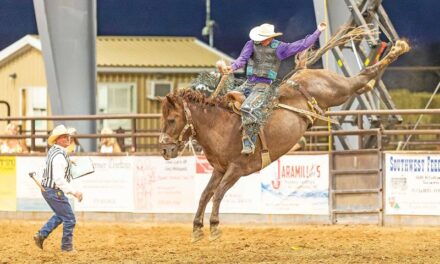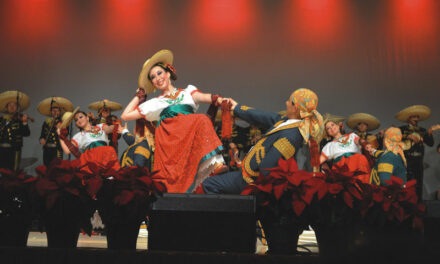The festival commemorating the feast of St. Michael the Archangel, the San Miguel Fiesta, one of the major community events every year, is yet another casualty of the corona-virus pandemic. This year’s celebration has been canceled.
San Miguel Church, founded in 1615, is one of the oldest churches in the state, and possibly in the nation, with a unique place in American history. Although no records were kept of the earliest days of the San Miguel Fiestas, the best estimate is that the event has been an annual affair in Socorro for over 100 years.
“It’s a community event,” church Deacon Nick Keller said. “The Fiesta has always been welcoming to everybody in town. And it’s quite a celebration. A lot of great entertainment. Good crowds. A lot of different things people could do. Sadly, it’s not happening.”
The decision to cancel was not made lightly, but Keller said it was unavoidable.
“The decision to cancel the San Miguel Fiesta entirely was in concert with the Archdiocese of Santa Fe, our pastor Father John (Anasiudu) and discussions with community members,” Keller said. “It was decided to do that instead of postponing it to another date, when we don’t know when, or whether or not, that could happen.”
He said that was the position of the Archdiocese for fiestas throughout the entire Diocese of Santa Fe. It was also decided that virtual fiestas were not workable.
The three-day San Miguel Fiesta is commonly the source for funding liability and fire insurance, not only for San Miguel Church, but also the St. Patrick’s Catholic Newman Center near New Mexico Tech and the seven mission churches; Polvadera, Lemitar, Luis Lopez, San Antonio, Magdalena, Kelly, and Riley.
“We customarily start planning the September Fiesta in July,” Keller said. “We try to get the major players, people who are going to support certain things like the hamburger booth or Mexican kitchen or barbecue, along with the silent auction and the kids’ games and whatever else people can come up with. Most of all of those make up the difference for what we don’t make with the raffle. This year we don’t have those.”
So, what will replace the fiesta, the major fundraiser for the church?
“The raffle being about the only thing we’re going to do,” Keller said. “The fiesta normally brings in around $30,000 or so, after all the expenses and everything. That gives us really enough to pay the insurance, which is about $29,000, then have a little bit left for certain ministries and so on. It’s a tough thing.”
Keller said although not all of the churches conduct regular services, insurance still must be paid on the buildings.
Tickets for the raffle are $2 each or a book of 10 for $20.
“People can pick up tickets at the Parish Office,” he said. “Right now, tickets are mailed to parishioners. Call the Parish Office to request tickets to be mailed to them.cIf there’s no answer they can leave a message.”
The first prize is $1,000. The second prize is $500. The drawing will be Saturday, October 17.
“The Feast of St. Micheal the Archangel is always September 29, and we normally schedule the Fiesta on the weekend around that date,” he said. “Moving the raffle back one month gives us a little extra time to distribute tickets.”
At this point in the pandemic, as with all houses of worship in New Mexico, San Miguel can accommodate 40 percent of the building’s occupancy, based on the fire marshal’s regulations, up from 25 percent when restrictions were first eased up.
“We’re up to 40 percent, so we can have 107 and we’re actually getting that,” Keller said “We have two masses scheduled. One at five o’clock on Saturday afternoon and one at eight o’clock on Sunday morning.”

A wide variety of music, contemporary to traditional, is customarily performed at the annual San Miguel Fiesta. Photo Wanda Moeller
He said plans are to add a 10 a.m. Sunday mass. “because we’re filling up with those two masses. That will help us a little bit with people that, regrettably, might be turned away.
“It doesn’t happen, but it could happen if we reach the limit of our capacity,” he said. “We would have to ask people to come back at another time. But that’s very rare.”
There is also a noon Mass on Sundays in Magdalena.
In normal times, services at the valley mission churches would alternate at 7 p.m. on Saturdays.
The story of Sam Miguel is one of Socorro’s enduring legends. The original mission was established in 1598 with the arrival of Don Juan de Oñate’s expedition and records show that the first building went up in 1612, making it the oldest in the state, and second oldest in the United States.
According to church records, two Franciscan priests with the expedition did missionary work among the Piro Indians. One of the priests, Father Alfonso Benavidez, was so successful in this work that he became known as “The Apostle of Socorro.” It was he who named the village Nuestra Senora de Perpetuo Socorro meaning: “Our Lady of Perpetual Help,” in recognition of the succor they received from the Indians.
In that same year, 1598, the two priests, with the help of the Indians, built a modest little church which they replaced with a larger building between the years 1615 and 1626. The work on the vigas and corbels took many months of tedious work, which can be understood readily by noting the careful and uniform carvings on beams were carved were cut and carried in from mountains many miles from Socorro.
The walls were built about five feet in width and the windows placed high to guard against attack from the unfriendly tribe of Navajo Indians.
Archaeological evidence shows that San Miguel Church roughly sits on the site of the original pueblo.
The mission was the center of the 17,000-acre Socorro Land Grant and served the area for the next 65 years. It continued to flourish until the outbreak of the rebellion in 1680 when most of the Piro Pueblo people joined the Spanish settlers in their retreat to what is now El Paso, Texas.
Although Don Diego de Vargas and a small contingent of soldiers re-conquered the Nuevo Mexico territory in 1692, it was several decades before any new settlers of Mexican and Spanish descent began to arrive in Socorro. On arrival, they found the church in a very dilapidated condition, but the massive walls and huge beams were still in place.
Part of the foundation of the original mission can be viewed through an opening in the floor near the front of the sanctuary.
Those Piro communities not served by a mission – Teypana, for instance, at present-day Luis Lopez – told a different story. Disease, tribute and labor demands, disruption of traditional trade relations, increasing Apache attacks, and recurring droughts combined to take a heavy toll on the Pueblos in general and the Piros in particular.
At some point around mid-century most, if not all, non-mission Piro pueblos were abandoned.
The descendants of the pueblo people were incorporated into an existing Spanish mission in Las Cruces.
The Church has gone under the name of San Miguel since about 1800.
Over the past few years, Albuquerque archeologist Michael Bletzer has conducted several digs at the church.
Jornada Research Institute, under the direction of Bletzer, conducted additional research in November 2014, to find traces of the Piro pueblo of Pilabó, which lies underneath modern Socorro and San Miguel Church. According to Bletzer, previous priests and church dignitaries are buried beneath the sanctuary and courtyard.



















